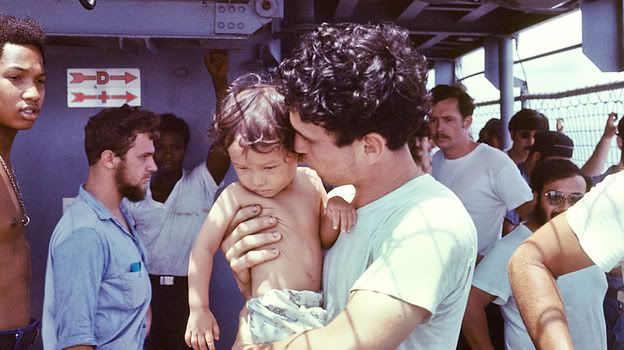... but then they'd never tell you anything about the USS Kirk's story.

You can read it here. Do so. Some exerpts:
"The Kirk steamed through the night to Con Son and reached the island just as the sun came up on May 1. There were 30 South Vietnamese navy ships, and dozens of fishing boats and cargo ships. All of them were packed with refugees, desperate to get out of Vietnam.
The ships "were crammed full of people," says Kent Chipman, who in 1975 was a 21-year-old machinist's mate in the ship's engine room and today works at a water purification plant in Texas. "I couldn't see below deck, but above deck the people were just as tight as you could get, side by side."
There was no exact count of how many people were on those ships. Some historical records say there were 20,000 people. Other records suggest it was as many as 30,000. Jan Herman, a historian with the U.S. Navy Medical Department, who is documenting the story of the Kirk, uses the higher number.
The Kirk sent its engineers to some of the boats to get them started.
....
After fixing what could be fixed on the seaworthy vessels and transferring people from the ships that would be left behind, the Kirk led the flotilla of naval ships, fishing boats and cargo ships toward the Philippines.
The USS Cook, another destroyer escort, like the Kirk, helped out as the ships were leaving Con Son. The Cook's crew provided rice, and its corpsman helped Burwinkel and his assistant from the Kirk attend to the sick and injured, too.
As the flotilla headed out to sea, on the way to the Philippines, other Navy ships came in and out of the escort, according to Herman. Among those other ships were the USS Mobile, USS Tuscaloosa, USS Barbour County, USS Deliver and USS Abnaki.
But it's clear from the daily logs from the Kirk and the other ships that the crew of the Kirk took the lead.
"For me, the Kirk was ideal," says Armitage, who moved from the Kirk to the Vietnamese navy's flagship. "It could communicate with the rest of the U.S. fleet. They would go with us across to the Philippines and would be able to rescue any of the folks who might be in harm's way. Some had been wounded. Some were pregnant. All were sick after a while. And we needed a way to take care of those folks."
The Kirk's sailors kept busy providing food, water and medicine to people on the South Vietnamese ships.
Burwinkel spent his time moving from ship to ship treating the sick and injured. With thousands of people — many of them babies and children — he had to work almost nonstop.
"When they gave me the meritorious service medal over all this, I quite frankly referred to it as my 'no-sleep' medal," says Burwinkel, who made a career in the Navy and is now retired and living in Pensacola, Fla. "I would go out there and do my thing and at dark we would come back to the Kirk and try to get a little bit to eat and make some rounds — gather my wits about me, resupply myself and get ready for the next day."
'Last Sovereign Territory Of The Republic Of Vietnam'
Of the some 30,000 refugees on vessels escorted by the Kirk over six days, only three died.
But as the flotilla approached the Philippines, the Kirk's captain got some bad news. The presence of South Vietnamese vessels in a Philippine port would present the government in Manila with a diplomatic predicament.
"The Philippine government wasn't going to allow us in, period, because these ships belonged to the North Vietnamese now and they didn't want to offend the new country," Jacobs, the captain, recalls.
The government of Philippine President Ferdinand Marcos was one of the first to recognize the Communist rulers now in control of a single Vietnam, and Jacobs was told the ships should go back.
Armitage and his South Vietnamese friend, Capt. Do, came up with a solution that Marcos had to accept.
Do recalls the plan: "We will raise the American flag and lower the Vietnamese flag as a sign of transfer [of] the ship back to the United States, because during the war those ships are given to the Vietnamese government as a loan, if you want, from the United States, to fight the Communists. Now the war is over, we turn them back to the United States."
There was a frantic search to find 30 American flags. Two officers from the Kirk were sent aboard each Vietnamese ship to take command after a formal flag ceremony.
Rick Sautter was one of the Kirk officers who took command of a Vietnamese ship.
"That was the last vestige of South Vietnam. And when those flags came down and the American flags went up, that was it. Because a Navy ship is sovereign territory and so that was the last sovereign territory of the Republic of Vietnam," he says.
"Thousands and thousands of people on the boats start to sing the [South Vietnamese] national anthem. When they lower the flag, they cry, cry, cry," Do remembers. "
Also, check out this video. How a young American woman of Vietnamese descent found out about the origins of her middle name.
A fine and proud ship, the USS Kirk:

Hat tip CDR Salamander.
MFBB.